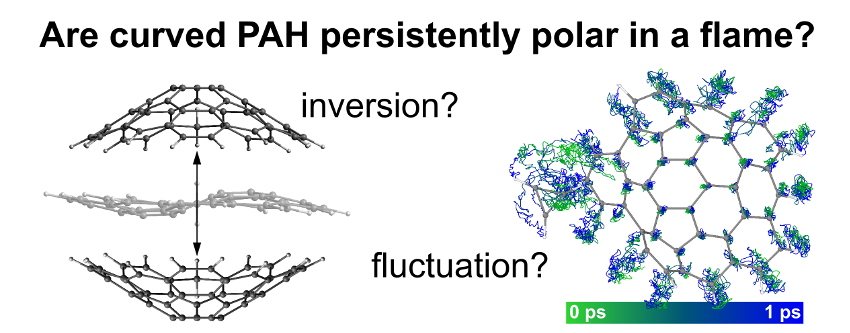Technical Report 220, c4e-Preprint Series, Cambridge
Dynamic polarity of curved aromatic soot precursors
Reference: Technical Report 220, c4e-Preprint Series, Cambridge, 2019
- The energy barrier for inversion increases rapidly from corannulene to cPAH 1 nm in diameter, which are anticipated to be rigid during soot formation.
- Smaller cPAH from 11 ≤ Nrings ≤ 15 are able to invert only if they have a single pentagon with cPAH > 2 pentagons being rigid.
- Ab initio MD simulations of a cPAH with 15 rings and two pentagons provided small fluctuations of the dipole moment at 1500 K, ±10-20%, as well as binding a chemi-ion, indicating the polarity of cPAH is persistent and of importance during soot formation.
 In this paper, we answer the question of whether polar curved aromatics are persistently polar at flame temperatures. We find, using electronic structure calculations and transition state theory, that the inversion barriers of curved aromatics (cPAH) of 0.9-1.2 nm in diameter are high and that they are not able to invert over the timescales and at the high temperatures found in sooting flames. We find a transition for smaller curved aromatics between 11-15 (≈0.8 nm) rings where the increasing strain introduced from the pentagonal ring increases the inversion barrier leading to rigidity. We then performed ab initio quantum molecular dynamics to find the molecular dipole fluctuations of a nanometre-sized cPAH at 1500 K. We found the bending mode of the bowl-shaped molecule gave rise to the largest fluctuations on the dipole moment by ±0.5-1 debye about the equilibrium value of 5.00 debye, indicating persistent polarity. We also observed binding of a chemi-ion at 1500 K over 2 ps, suggesting the molecular dipole of cPAH will be an important consideration in soot formation mechanisms.
In this paper, we answer the question of whether polar curved aromatics are persistently polar at flame temperatures. We find, using electronic structure calculations and transition state theory, that the inversion barriers of curved aromatics (cPAH) of 0.9-1.2 nm in diameter are high and that they are not able to invert over the timescales and at the high temperatures found in sooting flames. We find a transition for smaller curved aromatics between 11-15 (≈0.8 nm) rings where the increasing strain introduced from the pentagonal ring increases the inversion barrier leading to rigidity. We then performed ab initio quantum molecular dynamics to find the molecular dipole fluctuations of a nanometre-sized cPAH at 1500 K. We found the bending mode of the bowl-shaped molecule gave rise to the largest fluctuations on the dipole moment by ±0.5-1 debye about the equilibrium value of 5.00 debye, indicating persistent polarity. We also observed binding of a chemi-ion at 1500 K over 2 ps, suggesting the molecular dipole of cPAH will be an important consideration in soot formation mechanisms.
Material from this preprint has been published in Combustion and Flame.
PDF (4.1 MB)



